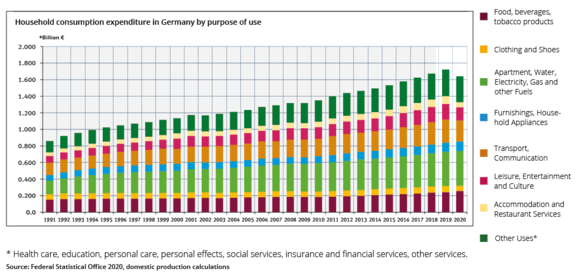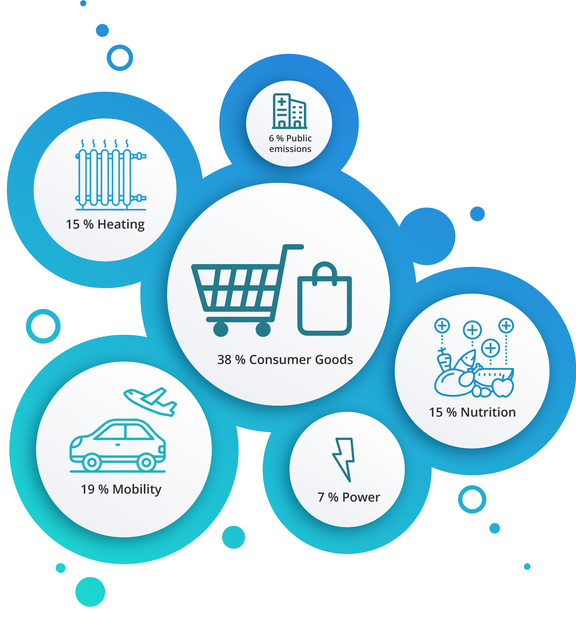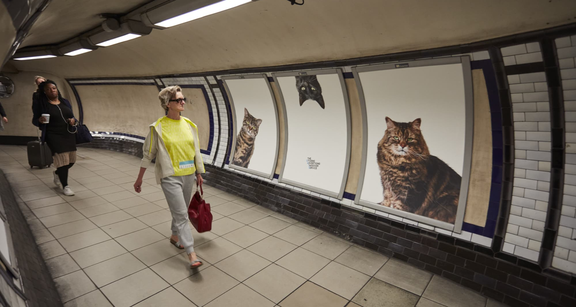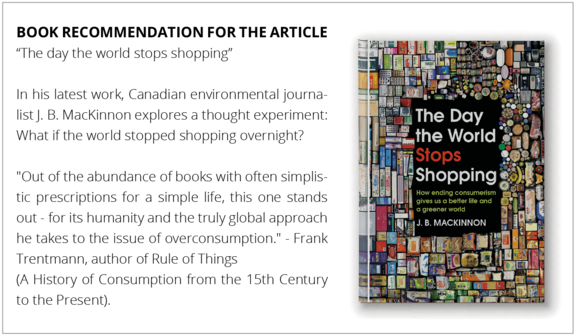![[Translate to Englisch:] hero konsumbefreiung](/fileadmin/_processed_/2/6/csm_hero_konsumbefreiung_01_3da5a8740b.png)
We live in a society that suggests satisfaction is strongly linked to material prosperity. In light of dwindling resources and social injustice in the production of goods*, the established standard of living is consuming beyond the means. The Earth Overshoot Day fell on May 4 in Germany this year. This day marks the point in time when the annually sustainably usable resources are completely depleted. However, in 2020, we experienced a shift of this day to 22 of August. In the following paragraph, it becomes clear that the pandemic had a strong impact on this development.
Carbon emissions fall simultaneously with the decline in consumption
Due to difficulties in supply and production caused by the Corona pandemic, world markets collapsed. Under these circumstances, a decline in consumption of around 5% was observed. Consequently, a significant decrease in CO2 emissions could be measured. The low traffic volume had a direct impact on air quality. The dwindling tourism made the water in the canals of Venice clear, so that the bottom became visible. Visibility in the cities cleared up and the stars were more visible at night.
The decline in economic activity has been directly reflected in a better carbon footprint. As soon as the commercialization of goods accelerates, more carbon dioxide is measured in the air. Under these circumstances, it is currently almost impossible to experience all-around green growth. Because the more that is consumed, the higher the emissions.
A brief look at modern consumer lifestyle
Consumer spending per household in Germany has grown steadily since 1991, as shown in Figure 1. According to the Federal Statistical Office (destatis), each person in Germany alone owns around 10,000 items. By comparison, 100 years ago, households made do with 180 items.
In Figure 2, the CO2 emissions of an average person (according to destatis, 9 tons per capita annually, as of 2019) are put in relation to consumption behavior. First and foremost, consumer goods are the most serious at 38%. Everyday items such as watches, clothing and electronic devices all have a carbon footprint, which is created primarily during production. The use of even small, seemingly incidental items also releases CO2. For example, electric toothbrushes, which can be found in 40% of German households. Without taking into account the emissions during production, 72 grams of carbon dioxide are emitted every day by these little helpers, simply because of the energy required to use them. This type of consumption occurs several times a day - primarily subconsciously - and accumulates throughout the day. According to the Federal Agency for Civic Education, the definition of consumption is "the use of goods and services for the immediate satisfaction of needs by private or public households."
This includes mobility, which accounts for 19% of CO2 emissions (see Fig. 2). The production of an average 1.5-ton vehicle consumes 70 tons of materials and resources. Depending on how long the vehicle remains on the road, 15-20% of the total CO2 emissions over the years have been generated in the production of the vehicle alone. Commuters who travel a total of 40 km emit 1.2 tons of carbon dioxide into the atmosphere every year. With per capita emissions of 9 tons of CO2 in Germany, that's a significant amount for one person.
The choice of diet, with a 15% share, also plays a significant role. Meat in particular is the subject of criticism. It should be noted here that even buying meat products locally needs to be questioned. According to a data collection by “Our world in data”, only 0.5-2% of emissions from beef production (18 kilos of CO2 emissions per kilo) are caused by transport and packaging. The remaining emissions are released during animal husbandry and care.
Heating of private households also has a high impact of 15 %. Turning up the radiators less and putting on a sweater instead can in itself mean relief for the environment and the wallet. You can find out more in our technical article "May it be a little less?" on page 8. In the article, an example model is used to investigate the effect of moderately sacrificing comfort, for example, on primary energy consumption for heating.
Innovations has its limits
According to a survey by Bitkom Research, half of Germans hope that the climate problem can be solved with technical innovation. Green technologies are on the rise in the form of electric cars, wind and solar energy, and organic food. Environmental journalist J. B. MacKinnon, in his book "The Day The World Stops Shopping," describes the facts this way: "In fact, since the turn of the millennium, the overall efficiency of our resource use has become less, while the rate at which we consume resources has increased. [...] What we've done so far to make our consumption more environmentally friendly hasn't kept pace with the growth of our consumer appetite." So from this point of view, for the time being, it is unlikely that we will be able to compensate for the problems of a consumer society by technical means in the near future without changing our lifestyle.
The rebound effect can also sabotage the good intentions of green consumer products. In this example, consider household appliances. Three decades ago, kitchen appliances were nowhere near as energy efficient as they are today, but we also owned far fewer kitchen gadgets back then. Put simply, the energy saved in one place is spent elsewhere. Thus, even after the introduction of energy-efficient appliances or products, electricity demand has continued to rise.
Buy yourself happy – what advertising does to us
Habits such as consumer behavior are difficult to change and, for example, are inherited from the parental home without being questioned. External factors, such as the arbitrary stimuli of the advertising industry and digital media in general, make it difficult to change our behavior. American linguist Noam Chomsky, one of the oldest intellectuals of our time, states "If you've ever turned on your TV, you know that hundreds of millions of dollars are spent to create uninformed consumers who make irrational decisions - that's what advertising is."
We operate in a complicated environment that constantly encourages us to consume with advertising. Yet advertising only shows what we don't have, leaving the potential consumer with a primarily bad feeling. Especially in public spaces, outdoor advertising is highly visible and cannot be ignored or turned off.
An artist collective from London called "Glimpse" created the "Citizen Advertising Takeover Service" (CATS). This action aimed to create a public space where we can feel comfortable. To this end, billboards were rented in London Underground stations. The result can be seen in Fig. 3: A hoard of cats look out at the busy people walking by. The CATS campaign attracted the attention of curious commuters and visitors, and people happened to strike up a conversation. A subway station turned out to be a space of encounters for the duration of the campaign.
Strengthening the culture of consumption
The deliberate shortening of a product's lifespan is known as “planned obsolescence.” Companies use this strategy to shorten the purchase cycle of products. This results in increasing sales and a growing economy that does not come to a standstill, as the market can never be saturated. This trend also stems from the demand of consumers who are hunting for bargains. Due to this, products are finished with cheaper, less durable or even inferior materials, which is accompanied by a shorter lifespan.
A well-known counter-example of a very durable product is a particular light bulb produced in the late 1900s. This one is a stately 120 years old and still illuminates a fire station in New York.
Consumption, no thanks?
Completely renouncing consumption in our society is an ambivalent undertaking. After all, we consume at all times, whether it's air or a good meal. But we have control over what we consume far beyond our basic needs. A counter-movement to the established consumer culture already exists. People who are turning away from consumerism and embracing simplicity are showing that consumer liberation can be possible. This lifestyle is characterized by the conscious and moderate use of goods. The pressure of excessive buying disappears, so that increased attention can be paid to one's own needs. Anyone who has ever done some research on the object of desire extensively in the course of a major purchase and compared different options will have noticed that consumption is “work” - in addition to a job.
According to estimates by the German Federal Environment Agency, emissions per capita would have to fall from 9 tons to 2 tons to halt global warming. A containable consumption would be a direct and viable measure to reduce the own ecological footprint and to actively counteract climate change.



